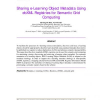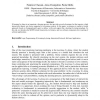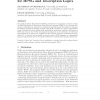276 search results - page 1 / 56 » E-learning by Doing with Computational Logic |
ITIIS
2008
13 years 3 months ago
2008
To facilitate the processes of e-learning resource description, discovery and reuse, e-learning objects should be appropriately described and classified using standard metadata th...
OTM
2004
Springer
13 years 10 months ago
2004
Springer
Abstract. This paper presents a knowledge-based approach to eLearning, where the domain ontology plays central role as a resource structuring the learning content and supporting ï¬...
AINA
2009
IEEE
13 years 11 months ago
2009
IEEE
— Mobile learning applications introduce a new degree of ubiquitousness in the learning process. There is a new generation of ICT-powered mobile learning experiences that exist i...
SOCRATES
2008
13 years 6 months ago
2008
E-learning by doing is an important e-learning process, that provides several advantages but that requires a high interactivity degree, not always supported in e-learning contexts...
IGPL
2007
13 years 4 months ago
2007
The graphical software Morph Moulder (MoMo) presented here was originally created for teaching the logical foundations of Head-Driven Phrase Structure Grammar (HPSG) in an e-Learn...



